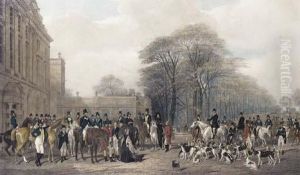Theodore Fielding Paintings
Theodore Henry Adolphus Fielding, commonly known as Th. Fielding or T.H. Fielding, was a notable English painter and engraver born in 1781. His artistic journey began under the tutelage of his father, Nathan Theodore Fielding, who was also a painter and engraver. The Fielding family had a significant artistic background, with several of his siblings, including Newton Fielding, Anthony Vandyke Copley Fielding, and Thales Fielding, also becoming proficient artists in their own rights.
Theodore Fielding's work primarily focused on landscape and marine subjects, and he became well-regarded for his watercolor paintings, which were praised for their delicacy and accuracy. In addition to painting, he was skilled in the art of aquatint engraving, a technique that enabled him to produce prints with tonal variation akin to watercolor paintings. Fielding's proficiency in aquatint made him a sought-after engraver for illustrating books, particularly travel books and guides, which were popular during the 19th century.
Apart from creating art, Fielding was involved in art education. He authored a number of instructional books on drawing and painting, such as 'The Art of Engraving, with the Various Modes of Operation' (1841). These books were valuable resources for amateur and professional artists alike and contributed to the dissemination of artistic knowledge during the period.
Despite his contributions to art and education, Theodore Fielding's work is less well-known today compared to some of his contemporaries. Nevertheless, his legacy persists through his published works and the influence he had on his students and readers. Theodore Fielding passed away in 1851, leaving behind a body of work that reflects a dedication to the depiction of the natural world and a commitment to the proliferation of artistic skills.
